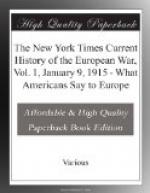“We have huge Celtic, Latin, Teutonic and Slavic populations all living here at peace and in harmony; and, as years pass, they tend to merge, creating new and homogeneous types. The Old World antagonisms have become memories. This proves that such antagonisms are not mysterious attributes of geography or climate, but that they are the outgrowth principally of social and political conditions. Here a man can do about what he likes, so long as he does not violate the law; he may pray as he pleases or not at all, and he may speak any language that he chooses.
“The United States is itself proof that most of the contentions of Europeans as to race antagonisms are ill-founded. We have demonstrated that racial antagonisms need not necessarily become the basis of permanent hatreds and an excuse for war.”
Hyphens Are Going.
“If human beings are given the chance they will make the most of themselves, and, by living happily—which means by living at peace—they will avoid conflict. The hyphen tends to disappear from American terminology. The German-American, the Italio-American, the Irish-American all become Americans.
“So, by and large, our institutions have proved their capacity to amalgamate and to set free every type of human being which thus far has come under our flag. There is in this a lesson which may well be taken seriously to heart by the leaders of opinion in Europe when this war ends.
“The second thing which we may press, with propriety, upon the attention of the people of Europe after peace comes to them is the fact that we are not only the great exponents but the great example of the success of the principle of federation in its application to unity of political life regardless of local, economic, and racial differences.
“If our fathers had attempted to organize this country upon the basis of a single, closely unified State, it would have gone to smash almost at the outset, wrecked by clashing economic and personal interests. Indeed, this nearly happened in the civil war, which was more economic than political in its origin.
“But, though we had our difficulties, we did find a way to make a unified nation of a hundred million people and forty-eight Commonwealths, all bound together in unity and in loyalty to a common political ideal and a common political purpose.
“Just as certainly as we sit here this must and will be the future of Europe. There will be a federation into the United States of Europe.
“When one nation sets out to assert itself by force against the will, or even the wish, of its neighbors, disaster must inevitably come. Disaster would have come here if, in 1789, New York had endeavored to assert itself against New England or Pennsylvania.
“As a matter of fact, certain inhabitants of Rhode Island and Pennsylvania did try something of the sort after the Federal Government had been formed, but, fortunately, their effort was a failure.




